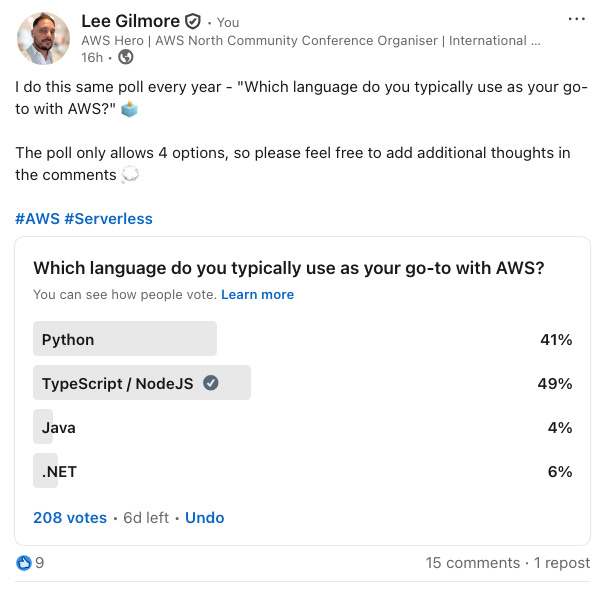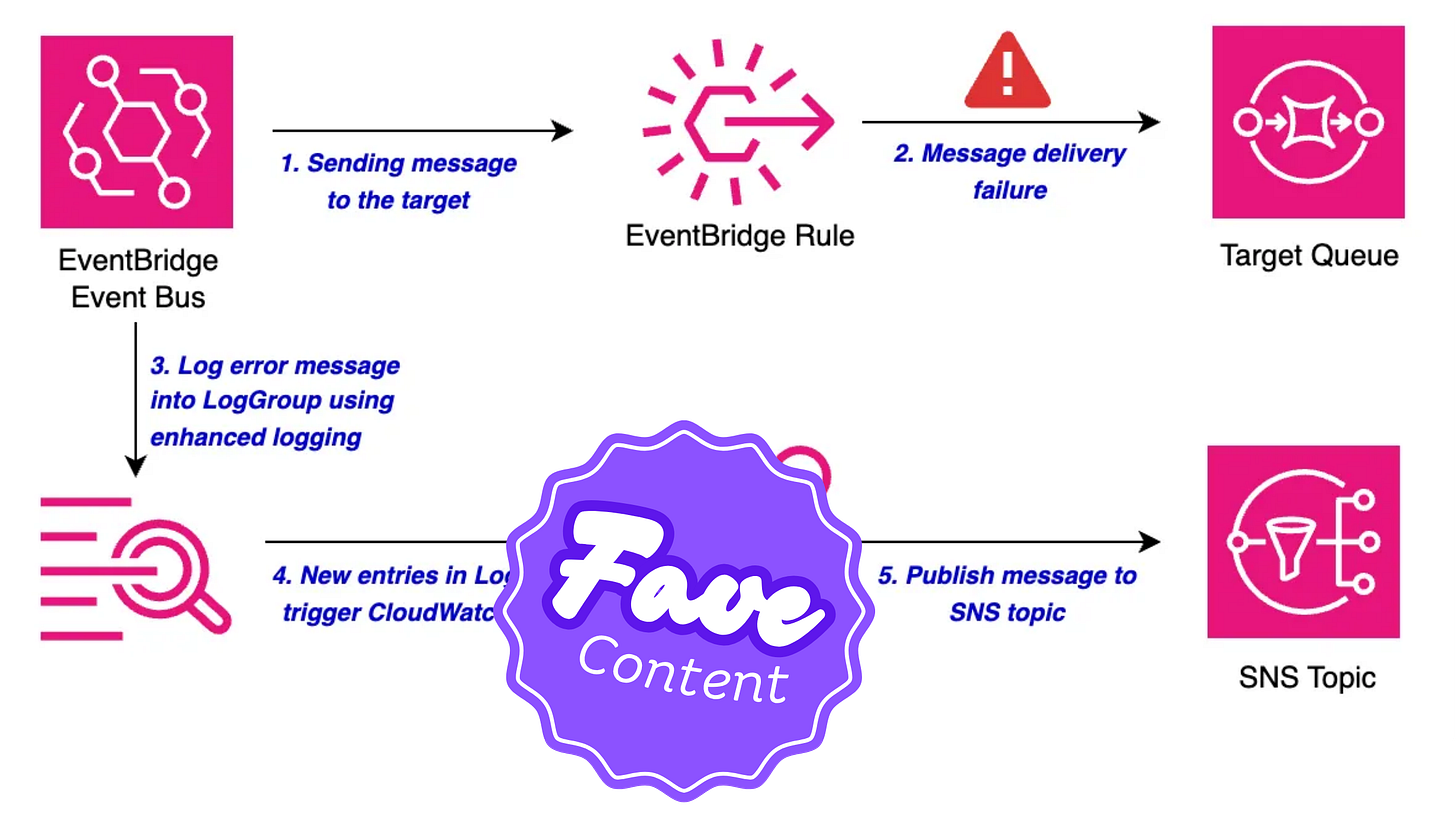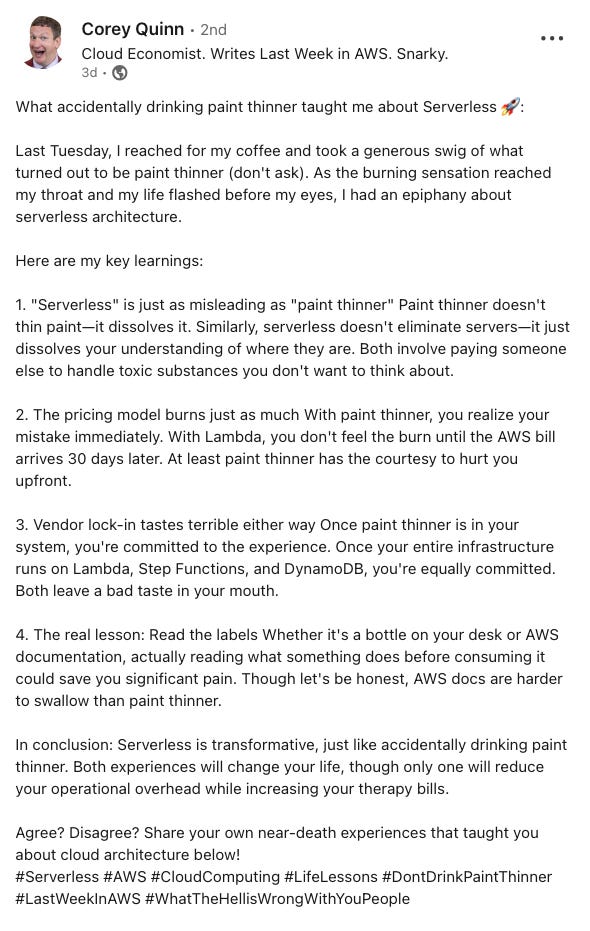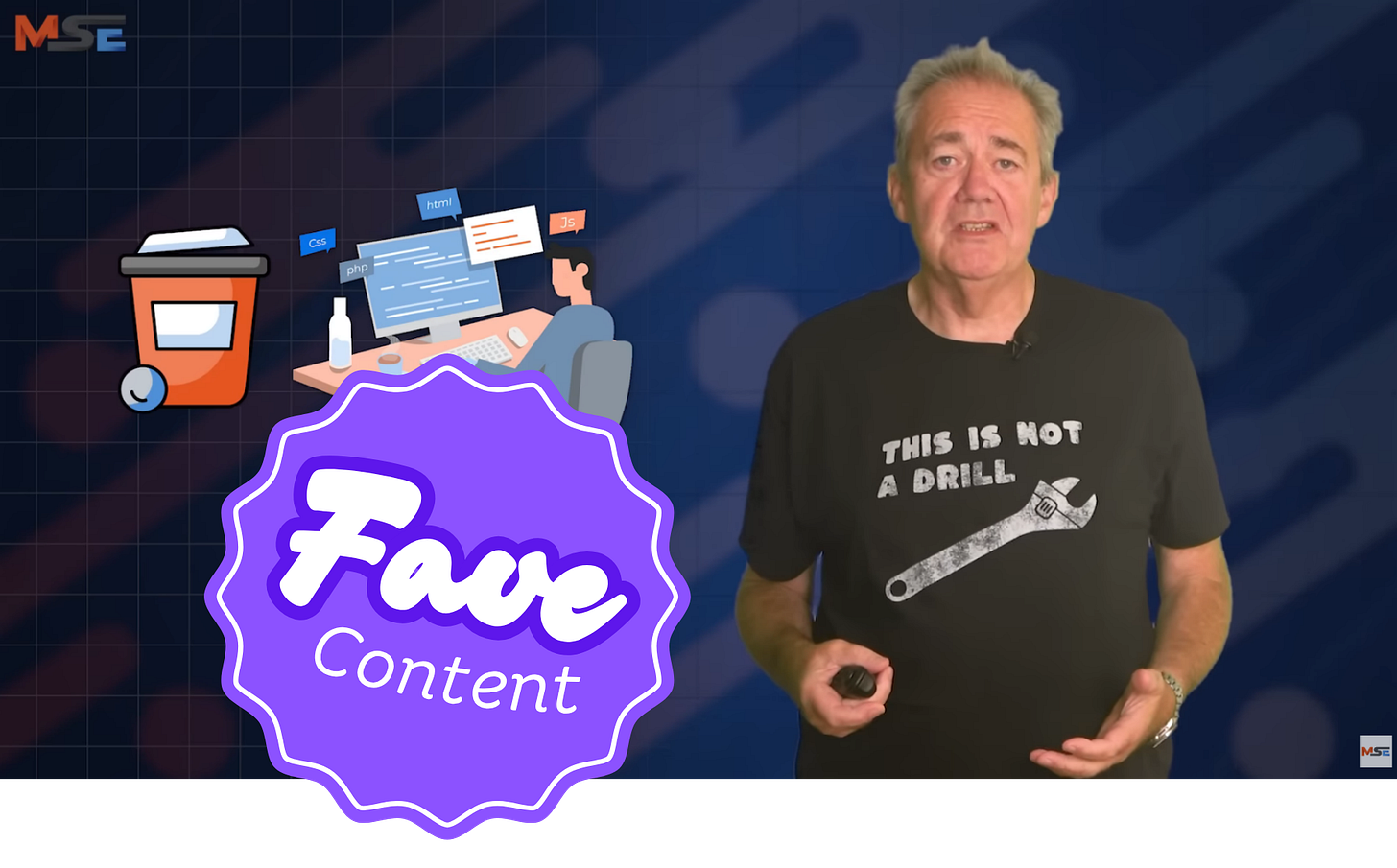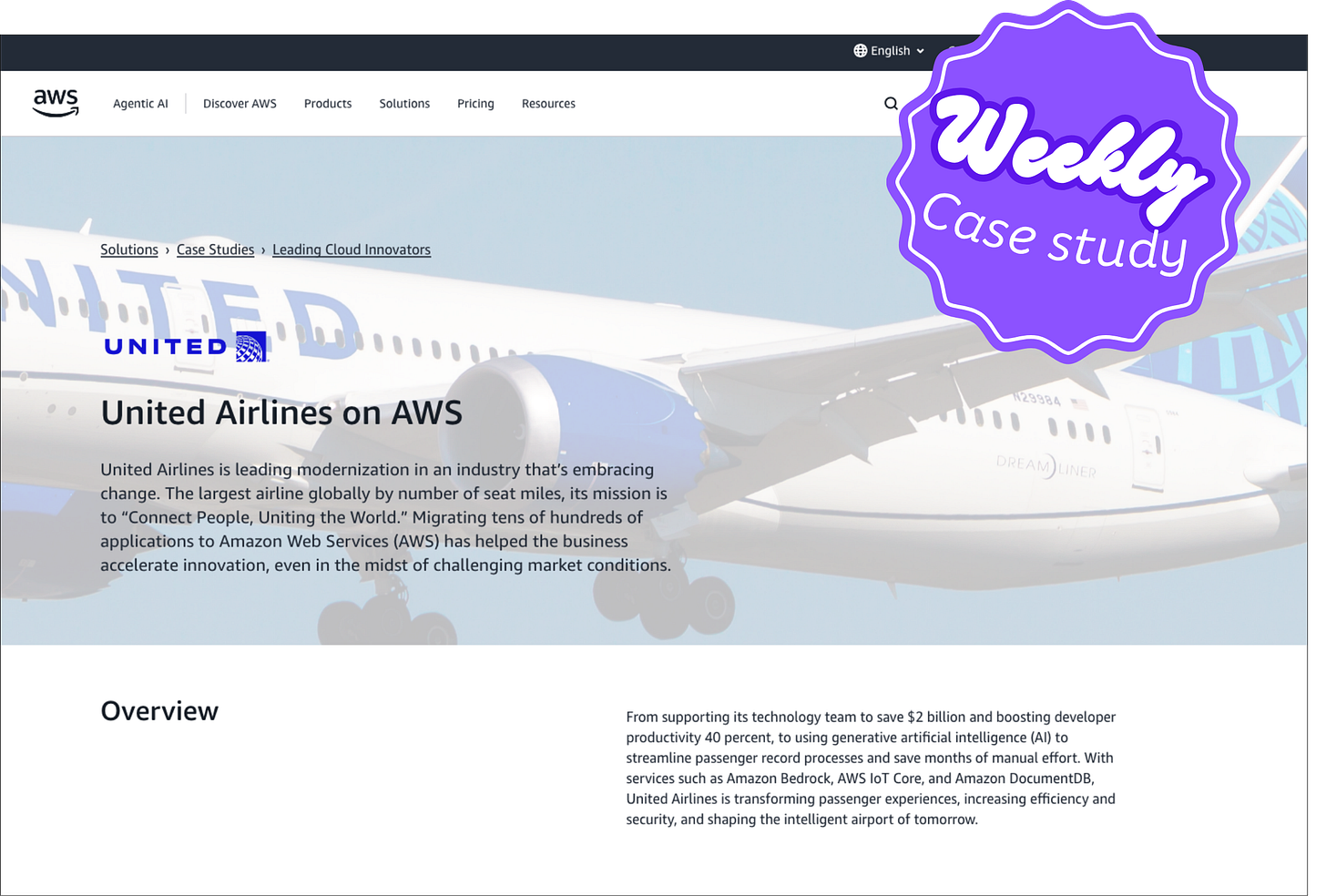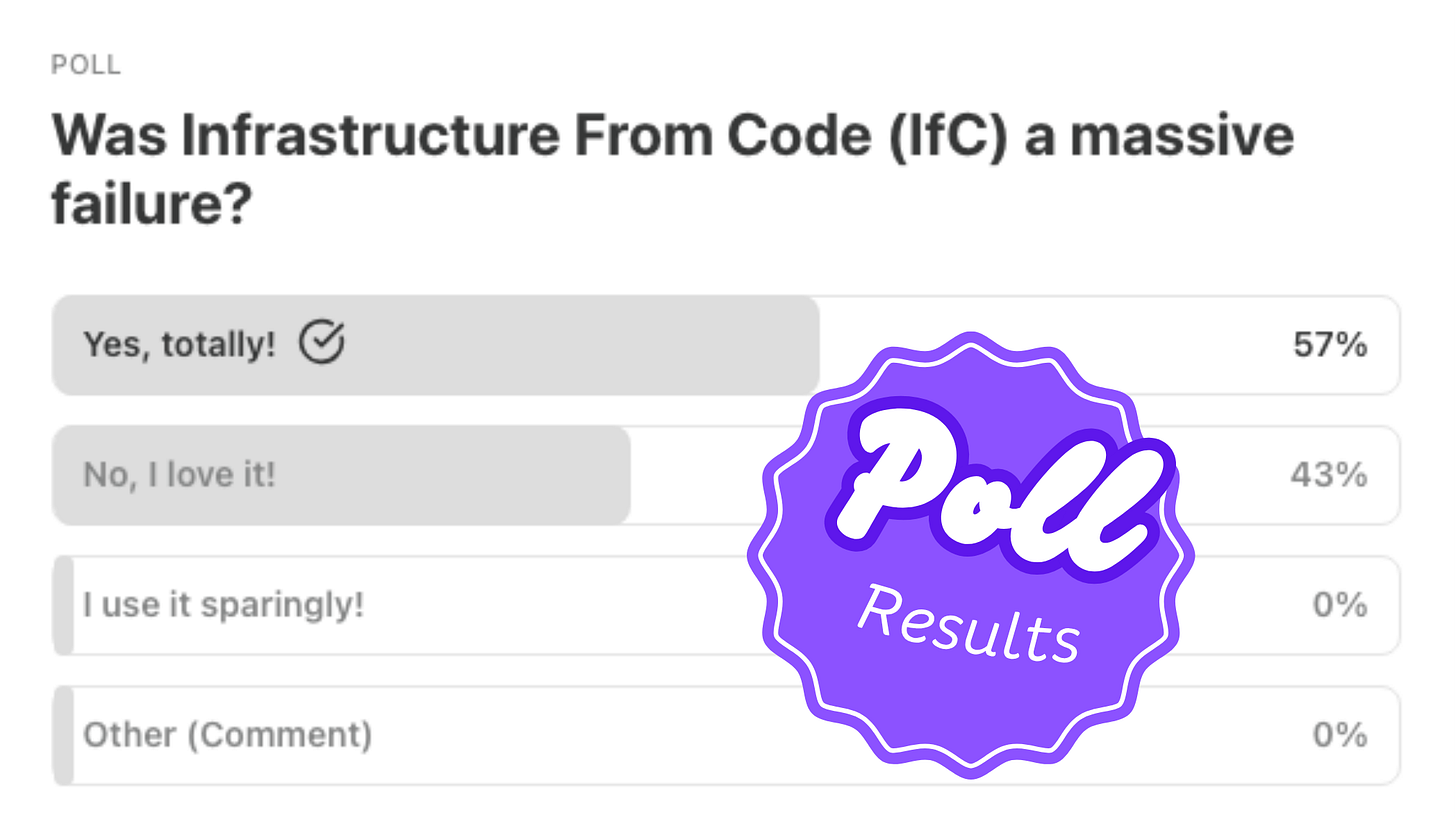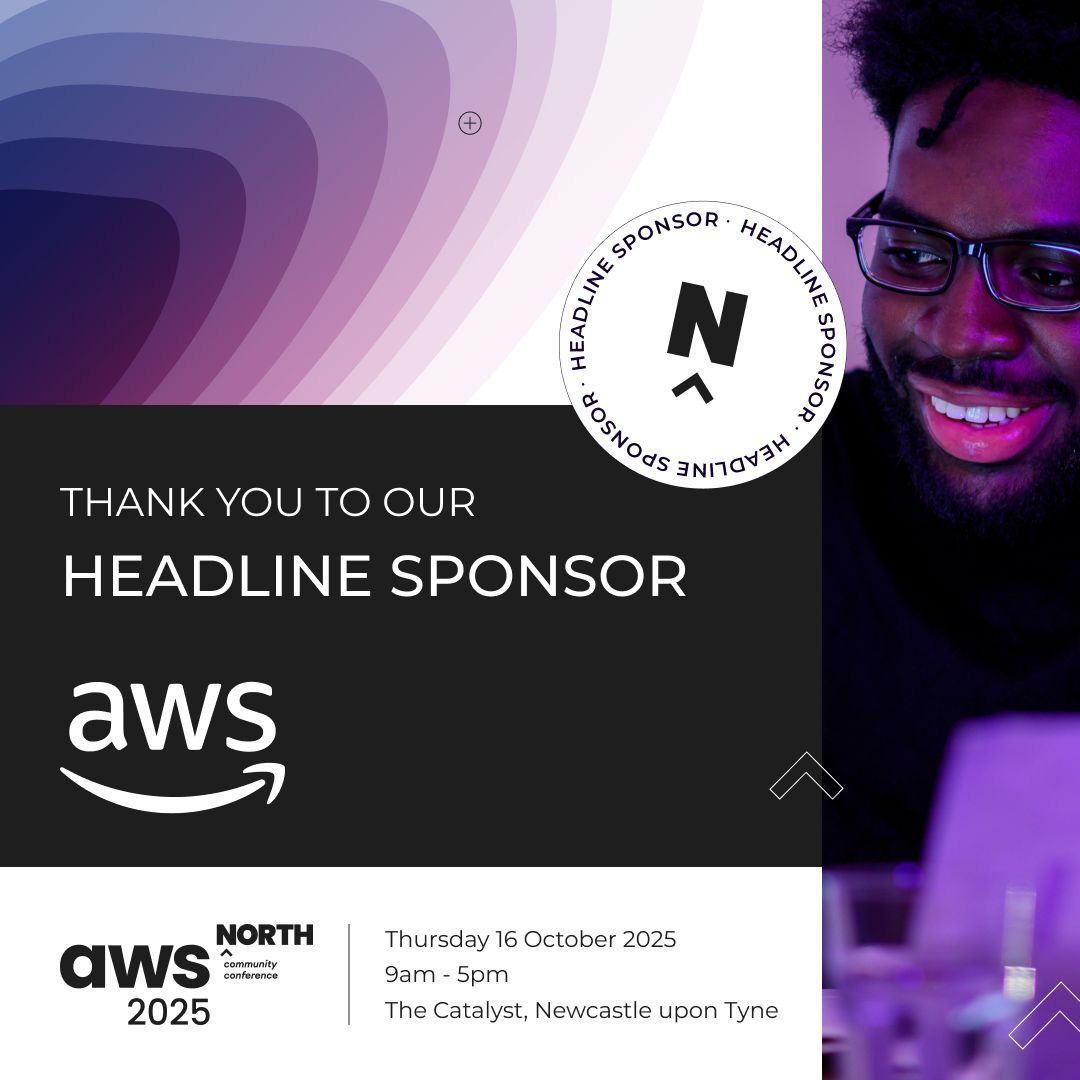#56 Serverless Events ✉️
This week, our expert is AWS Community Builder Guilherme Dalla Rosa, our spotlight falls on AWS Lambda Senior Software Engineer Maxime David, and we look at the latest service releases, news, & more!
Welcome
In last week’s issue, our serverless expert was AWS User Group Leader Tom Misiukanis, and our spotlight fell on AWS Community Builder Guilherme Dalla Rosa!
This week, our serverless expert is AWS Community Builder Guilherme Dalla Rosa, our spotlight falls on AWS Lambda Senior Software Engineer Maxime David, and we look at the latest AWS service releases, blog posts, hints and tips, news and more!
This week’s newsletter is sponsored by Leighton.
A Glimpse into My Week 🎤
This week we have been continuing to get ready for our AWS conference, which is in less than 2 weeks’ time! If you would like to get a discount on tickets, please use the code ‘LEE_SENT_ME’ at checkout for 20% off.
🎟️ Go check out the speakers here!
I also asked the community two key questions in polls this week on LinkedIn:
“Which IaC framework is your go-to for your AWS solutions?“ and “Which language do you typically use as your go-to with AWS?“.
If you want to get a sneak peak of the results one day in, you can see them below (feel free to follow along to get the final results). At the moment the front runners are TypeScript/NodeJS using the AWS CDK.
Let’s see the results after another six days, and we will cover in next weeks issue.
📰 Articles that caught the eye
Here are some stand-out articles I read during the week in the World of Serverless, AI, Engineering and Architecture!
⭐ My favourite this week was by Pubudu, covering his trend of EventBridge!
Marcin Sodkiewicz covers how to ‘Protect CloudFront. Fast. With no Code‘.
Vadym Kazulkin has another article in his series titled ‘Micronaut 4 application on AWS Lambda- Part 4 Reducing Lambda cold starts with SnapStart and API Gateway request event priming’.
Marko Milosavljevic discusses ‘S3 Lifecycle rules with Terraform‘ in this article.
Sebastian Bille tries to save you money in this article, ‘How to save thousands of dollars on AWS WAF’.
Pubudu Jayawardana is back at it again, this time covering ‘Detect EventBridge target failure: Part 2— using enhanced monitoring‘.
The Anthropic team have an interesting article titled ‘Effective context engineering for AI agents‘.
Marcos Henrique has a great article titled ‘Building an Agentic Medical Analysis System That Actually Thinks‘.
Sena Yakut covers ‘Exploiting Misconfigured S3 Bucket Access in Serverless Applications‘.
Another guidance blog post for re:Invent titled ‘Ultimate tips for attending AWS re:Invent 2025‘ by Angelo Mandato.
AWS release ‘Guidance for Deploying Model Context Protocol Servers on AWS‘.
Jacek Kościesza continues his series, this time covering ‘Videos GraphQL API with AppSync, Lambda, DynamoDB - FakeTube #6‘.
🎓 Ask the Expert
Each week, I ask a different serverless expert the same three questions to get their personal insights - this week, we have AWS Community Builder Guilherme Dalla Rosa:
Opinions are the author’s and do not express the views of their employer.
1. What is one common mistake you see teams making when implementing serverless solutions, and how can they avoid it?
The pattern I notice most often is teams making tactical service choices instead of thinking architecturally from the start. This isn’t about blame. Most of us learn serverless by shipping fast, experimenting, and figuring things out as we go. But what works for a proof of concept often creates friction at scale.
Here’s how this plays out in practice:
Service limits hit you at scale. SQS FIFO queues have different throughput compared to standard queues. API Gateway REST and HTTP APIs aren’t interchangeable. Parameter Store has small quotas that quickly cause throttling. DynamoDB requires capacity planning and careful table design that aligns with your access patterns. Teams typically discover these constraints in production, not during the design phase.
Lambda becomes the default answer. The Lambdalith problem is well known. Less discussed is using Lambda as glue code when services can integrate directly. Every unnecessary function adds cold start latency and operational overhead.
Event-driven patterns lack guardrails. Teams jump into event-driven architectures without understanding the fundamentals. No DLQ for failed events. No idempotency handling for duplicate processing. Message queues or streams can overwhelm downstream services if you don’t limit parallel Lambda invocations. External APIs are often overwhelmed because nobody considered concurrency controls.
Cost implications come as surprises. Patterns often appear cheap during development but become expensive at production volumes. Many teams fail to provide developers with access to billing data, which is a mistake. You can’t optimise what you can’t see. Developers need visibility into how their architectural choices translate to dollars.
Avoiding this starts with architectural thinking, not service selection. Understand the throughput characteristics and pricing models. Look for direct integrations first: API Gateway writing to DynamoDB, EventBridge Pipes routing events, Step Functions using native SDK integrations. These functionless patterns reduce cost and latency while cutting operational complexity.
Design with boundaries so you can swap components later. That Lambda handling heavy workloads? It might become a Fargate task later. Hexagonal architecture principles make this possible. Build observability from the start. Distributed tracing, structured logging, and metrics aren’t afterthoughts. They’re how you understand what’s happening when systems scale.
2. Which serverless tool or service are you most excited about right now, and why?
Aurora DSQL. For years, teams building serverless applications hit the same wall with relational databases. Aurora Serverless v2 can scale-to-zero, but you still end up paying for idle time. Also, production workloads can’t tolerate the resume latency, so you end up paying to keep capacity warm anyway. That’s not serverless. DSQL finally delivers what we’ve been waiting for: true serverless for relational data with the scalability characteristics of DynamoDB but the query flexibility of PostgreSQL.
DSQL delivers what we’ve been waiting for. True serverless experience with low latency and virtually unlimited scalability out of the box. Think DynamoDB but for relational data. The multi-region, multi-cluster setup provides 99.999% availability, making it perfect for workloads that can’t tolerate downtime.
The reality check? It’s not a drop-in replacement for PostgreSQL. The lack of foreign keys and the limit on the number of records you can mutate in a transaction might block migration or adoption for some use cases. But as an alternative to DynamoDB? It’s compelling. When you need a defined schema or have multiple access patterns, DSQL fills a gap that has existed in the serverless ecosystem for years.
3. What is your favourite trick or tip when working with serverless that the readers may find interesting?
Don’t start from scratch. The serverless ecosystem has matured enough that you can learn from others who’ve already solved similar problems. Blueprints aren’t just shortcuts for implementation. They show you how to architect for scalability and security from the start. The Well-Architected Framework, especially the Serverless Application Lens, covers common scenarios and identifies key elements for production-ready workloads. The community shares real-world use cases and hard-earned lessons. Learn from their mistakes instead of repeating them.
Use tools built specifically for serverless workflows. Powertools helps you to eliminate boilerplate for logging, tracing, and metrics and AWS Lambda Power Tuning will find the optimal memory configuration for your functions. For AI workloads, the Strands framework simplifies building agentic applications. These tools encode best practices, so you don’t need to guess.
✅ Bonus tip: join the hashtag#believeinsls discord! There is a community there to answer any questions you may have without getting overzealous on serverless or without judgment! Check it out!…
🧠 Tips & Tricks
This week’s tip or trick comes from my AWS Practice at Leighton, and a nice performance tip when working with Jest for your unit tests. You can swap out the ts-jest runner in your Jest config for @swc/jest and your tests will speed up dramatically!
The reason for this is that it is a Rust drop-in replacement for ts-jest, and there is a reason SWC stands for ‘Speedy Web Compiler’! Go try this out!
🚀 New Releases
Here are the latest and most interesting releases this week in the AWS World:
⭐ This week, my favourite service release was the introduction of Claude Sonnet 4.5 in Amazon Bedrock!
Amazon OpenSearch Ingestion now supports batch AI inference.
Amazon Bedrock Data Automation now provides support for enhancing transcriptions.
Application map is now generally available for Amazon CloudWatch.
Amazon Detective now supports AWS PrivateLink for private API access.
Amazon CloudWatch and OpenSearch Service expand region support for integrated analytics experience.
Announcing Amazon ECS Managed Instances for containerized applications.
Amazon SNS expands IPv6 support to the AWS GovCloud (US) Regions.
Amazon Kinesis Video Streams now supports IPv6 for Streams capability.
Open Source Model Context Protocol (MCP) Server now available for Amazon Bedrock AgentCore.
🔥 Tip: Check out https://aws-news.com/ for the very latest up-to-date serverless releases as they happen, created by the talented AWS Serverless Hero Luc van Donkersgoed.
✖️ Social of the Week
This week’s social is by Corey Quinn on LinkedIn, talking about ‘Serverless’:
I thought this was just satire at first, but I think this is actually just a really bad take on Serverless. Everybody wants predictable costs, but also zero costs when systems are not being used! They also often cite vendor lock-in, but also want all ops and maintenance to be done by somebody else, and for everything to scale “automagically” without lifting a finger. Serverless is not a magic bullet, and like anything else, there are always tradeoffs - but comparing it to paint thinner just feels poor.
Feel free to leave a comment below.
👷🏻 Tools & Frameworks
Check out the latest open-source frameworks, news, and tool updates from the past week.
chrome-devtools-mcp - lets your coding agent (such as Gemini, Claude, Cursor or Copilot) control and inspect a live Chrome browser. It acts as a Model-Context-Protocol (MCP) server, giving your AI coding assistant access to the full power of Chrome DevTools for reliable automation, in-depth debugging, and performance analysis.
Kubernetes 1.34 is now available on Amazon EKS - K8s version 1.34 now available in EKS.
AWS API MCP Server v1.0.0 - AWS announces the v1.0.0 release of the AWS API model context protocol (MCP) server enabling foundation models (FMs) to interact with any AWS API through natural language by creating and executing syntactically correct CLI commands.
reinvent-mcp-2025 - Comprehensive Model Context Protocol (MCP) server providing intelligent access to AWS re:Invent 2025 session catalog with 1,843 sessions, advanced search capabilities, and speaker discovery.
bitnet.cpp - bitnet.cpp is the official inference framework for 1-bit LLMs (e.g., BitNet b1.58). It offers a suite of optimized kernels, that support fast and lossless inference of 1.58-bit models on CPU and GPU.
AWS Knowledge MCP Server - AWS announces the general availability (GA) of the AWS Knowledge Model Context Protocol (MCP) Server.
😂 Just for Fun
This week’s post is by Daniel Moka on LinkedIn:
I was on a project for almost four months where I lived this life (but also approving and merging my own PRs too!)
The comments are equally as fun by the way, so go check them out!
🎙️ YouTube & Podcasts
Here are some of my favourite videos and podcasts this week covering serverless, AI, architecture, and software engineering.
⭐ My favourite video this week was by Dave Farley asking the question if engineers are quitting microservices.
Pravesh Sudha discusses the ‘Top 5 Terraform Security Mistakes You MUST Avoid!‘.
The Believe In Serverless channel covers ‘AI Agent Design Principles: How Much Context is too Much?‘.
Dave Farley asks the question ‘Why Are Software Engineers Quitting Microservices?‘.
The Prime covers ‘So This Is Why Meta’s Demo Failed‘.
Chris Simon discusses ‘A Defence of Technical Excellence‘ on DDD Europe.
Tudor Girba & Kris Jenkins discuss ‘Moldable Development & Glamorous Toolkit in Practice‘.
The Serverless Craic episode 74 covers ‘Serverless, AI & Bedrock AgentCore‘.
Also, a heads up to go follow Allen and Andres new YouTube channel ‘Null Check TV’ which they have just setup 👇🏼
Weekly Case Study 🔍
This week’s case study comes from United Airlines:
United Airline’s use case is a large-scale modernisation and innovation effort, migrating hundreds of applications to the cloud to transform passenger experiences.
The airline utilises AWS services like Amazon Bedrock for generative AI, AWS IoT Core, Amazon DocumentDB, Amazon Elastic Container Service (ECS), and AWS Fargate to achieve this. This work saved the technology team $2 billion, boosting developer productivity by 40%, and using AI to streamline passenger record processes, avoiding months of manual effort.
🗣️ Inspirational Quotes and Thoughts
This week’s inspirational quote is by American systems engineer, consultant, and author, Tom Gilb:
“Architecture is a hypothesis, that needs to be proven by implementation and measurement.“
Tom Gilb
This is such a great quote on software architecture, as our beautiful architecture designs are often just that, designs (boxes and lines), and the only way to verify them is by actual implementation, and seeing how well they met the business brief and the requirements.
It’s only often when we implement an architecture design that we realise our key metrics may not be viable: whether that be scale, cost, speed etc
What are your own thoughts and experiences of this quote? Feel free to leave a comment below.
🗳️ Poll of the Week
In last week’s poll, we asked the question “Was Infrastructure From Code (IfC) a massive failure?”.
I was really surprised that not more than 57% said yes, as personally I have always thought it brings a huge level of coupling to the framework, and wouldn’t personally use it on any projects.
This week, we ask the question: “What is your go-to for configuration in AWS CDK applications?“
Do you generate your application config dynamically through scripts, do you use the more static cdk.json, or perhaps storing all config in parameter store? Please feel free to leave a comment below on your answer.
📅 Serverless Events
The following serverless events are upcoming, so mark your calendars.
🎟️ To note, tickets are available for the AWS North Community Conference, which I am helping organise, so go check it out!
Other fantastic events happening soon:
ACD DACH - 7th Oct 2025
ACD Nordics - 10th Oct 2025
AWS North Community Conference - 16th Oct 2025
ServerlessDays Milano - 21st Oct 2025
ServerlessDays Cardiff - 23rd Oct 2025
Serverless Architecture Conference - 20th-22nd Oct 2025
ServerlessDays Sao Paulo - 5th Nov 2025
Do you have any upcoming events that you want to highlight? Message me below!
⭐ Spotlight
This week’s spotlight falls on AWS Lambda Senior Software Engineer Maxime David!
Maxime is an open-source contributor, YouTube content creator, international speaker, podcast speaker, OpenTelemetry contributor, creator of the ‘Advent of Rust’, live stream guest, creator of lambda-perf, and more; as well as being a Senior Software Engineer on the team who build Lambda @ AWS! (very cool!)
Here is a great example of one of Max’s talks at re:Invent covering Lambda cold starts!
Thank you for everything you do for our amazing community Maxime!
Thank you for reading the latest Serverless Advocate Newsletter!
If you want to find out a little more about me, please have a look at:
https://www.serverlessadvocate.com/
See you next time,
Lee






